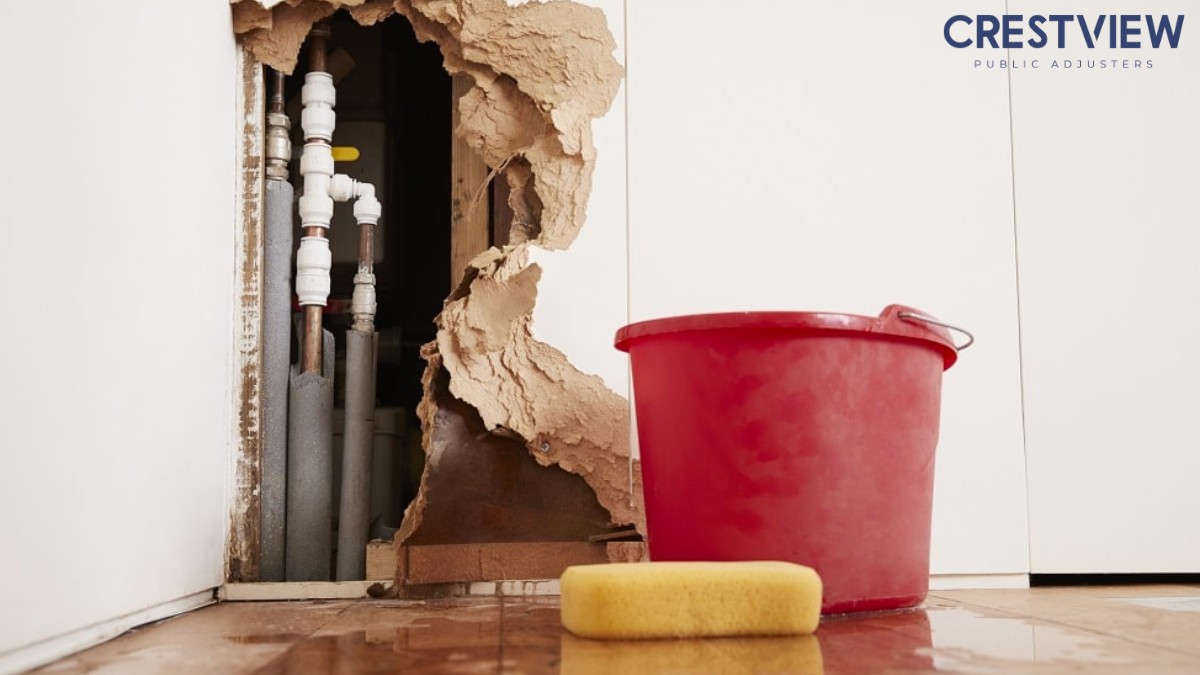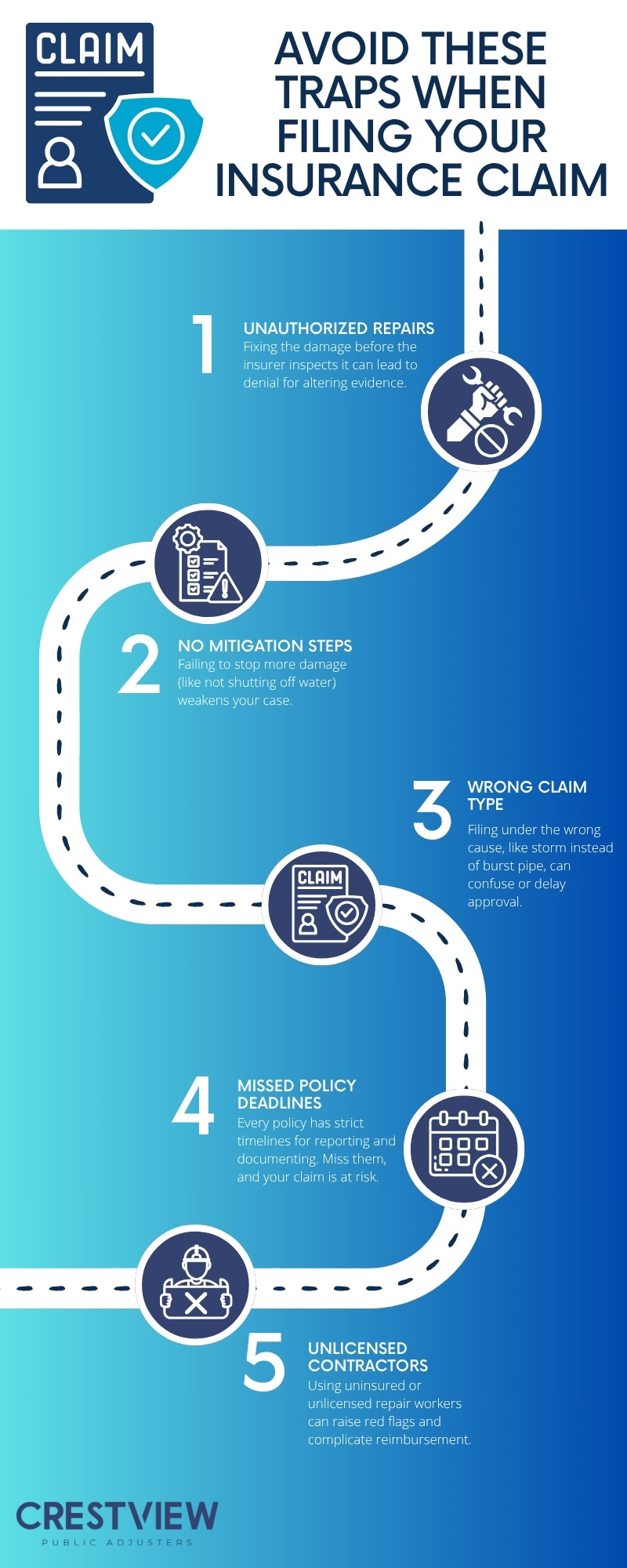Key Points:
- Insurance companies often deny water damage claims due to exclusions in the policy or delayed reporting.
- Poor maintenance, pre-existing damage, or lack of evidence can also lead to claim denial.
- Understanding common pitfalls can help policyholders avoid costly mistakes and improve their chances of approval.
Water damage claims are commonly denied due to policy exclusions, delayed reporting, or lack of proper documentation. Many claims fall through because homeowners don’t fully understand what their insurance covers—or fails to cover.
Yet, a large percentage of these claims are denied, leading to frustration and financial stress for homeowners. The good news is, many of these denials can be prevented with a deeper understanding of the claim process and common insurer tactics.
Does Homeowners Insurance Cover All Types of Water Damage?
Not all water damage is covered by homeowners insurance. Coverage largely depends on the source of the water, how suddenly the damage occurred, and whether it could have been prevented. Most policies exclude gradual damage, flooding from natural disasters, or claims tied to poor maintenance. This is why knowing the top reasons water damage claims are denied is crucial to protecting your home—and your wallet.
Policy Exclusions: What Your Insurance Won’t Cover
One of the most overlooked reasons water damage claims are denied is hidden in the fine print: exclusions. Many homeowners believe their insurance will cover all water-related damage, only to find out their policy doesn’t include certain situations.
Policies typically cover “sudden and accidental” water damage—like a burst pipe. But they exclude gradual damage such as:
- Leaks that developed over time
- Damage from poor drainage
- Long-term roof deterioration
- Mold caused by unresolved water exposure
Another common exclusion is flooding from natural disasters, which isn’t covered under standard homeowners insurance. If the water comes from the ground up (e.g., storm surge, river overflow), you’ll need a separate flood insurance policy.
Also, backup from sewers or drains may not be covered unless you’ve purchased specific endorsements. It’s essential to read your policy carefully and ask your insurer about coverage gaps.
Delayed Reporting: Time Is Not on Your Side
Time is critical in water damage claims. The longer you wait, the harder it becomes to prove that the damage was sudden—and not a result of neglect. Most insurance policies require “prompt notice” of a loss. Waiting even a few days can give insurers the leeway to deny your claim.
Delays can also worsen the damage. For example, water left sitting for several days can lead to mold, weakening your position if the insurer argues you failed to mitigate further loss.
Here’s what delayed reporting can trigger:
- Denial based on policy language requiring timely notice
- Accusations of negligence or poor maintenance
- Disputes over when the damage actually occurred
To avoid this pitfall:
- Report the issue as soon as it happens—even if you’re unsure it’ll be covered.
- Document everything: photos, videos, repair receipts, plumber’s reports.
- Take reasonable steps to stop further damage (e.g., turn off water supply).
Speed and documentation are your best allies when dealing with water damage claims.

Poor Maintenance and Negligence
Insurance is not a maintenance plan. If your water damage is caused by something that should have been fixed long ago, the insurer can argue that it’s your fault. In fact, poor home maintenance is one of the top reasons water damage claims are denied.
Common scenarios that fall under this include:
- A leaky roof that was never repaired
- Plumbing corrosion ignored for months
- Old water heaters past their life expectancy
- Cracks in the foundation that allow water seepage
Insurance adjusters are trained to look for signs of neglect. If they find any evidence that you failed to maintain the area affected by water damage, they may deny your claim—even if the damage seems sudden to you.
To prevent this:
- Schedule routine maintenance of plumbing, appliances, and roofing.
- Keep detailed records of repairs or professional inspections.
- Fix minor issues before they become bigger problems.
Even if you feel the damage was beyond your control, if you failed to maintain your property, your insurer could still deny the claim.
Insufficient Documentation or Evidence
No proof? No payout. It’s that simple. One of the most frustrating ways to get denied is simply failing to show proper evidence of the damage or the event that caused it.
Insurance companies require you to prove:
- The cause of the damage
- The date it occurred
- The extent of the loss
- Your efforts to stop further damage
Missing receipts, before-and-after photos, or lack of a plumber’s report can work against you. The burden of proof is on the policyholder.
Here’s what you should always document:
- Photos or video of the affected areas
- Receipts for emergency repairs or temporary accommodations
- Contractor estimates for repair costs
- Any written communications with the insurer
Start building your file the moment you discover the damage. Organized documentation can be your strongest defense if a claim goes south.
Disputes Over the Source of Damage
Addressing water damage starts with identifying the source, as insurers often deny claims by disputing where the water came from.
For example, you may believe a burst pipe is to blame, but the adjuster might say the water seeped in from the ground—which could classify the event as a flood (not covered under standard policies). These subtle distinctions are often the root cause behind denial.
Common disputed sources:
- Rain vs. roof failure
- Pipe leak vs. seepage from foundation
- Appliance failure vs. user error
Even if your claim is valid, an insurer may intentionally reclassify the event to fit within an exclusion. Without expert support, you could lose a legitimate payout.
This is where an experienced public adjuster can make a big difference. They’ll help investigate the root cause and push back against unfair classifications used to justify a denial.
Pre-Existing Damage Clauses
Many policies include language that excludes pre-existing damage, which can get murky during a water damage claim. If there’s any suspicion that the issue didn’t start recently, insurers might argue that it was present long before the claim was made.
This is especially true in properties with older infrastructure or past issues with leaks. Even cosmetic signs like discoloration or warped flooring can lead to a denied claim.
What makes this tricky is that insurers don’t always require proof to deny a claim—they just need reasonable suspicion that the problem existed before the event date you provided.
To counter this:
- Have inspection records on file
- Keep dated photos of problem-free areas
- Address minor water issues before they become claims
Always seek an expert opinion from a contractor or public adjuster who can help establish a timeline for the damage and challenge the insurer’s assumptions when possible.
Quick Claim-Killers to Watch Out For
Even if your damage seems covered, small mistakes can derail your entire claim. Here are a few fast-track reasons insurance companies say no:

Take Action with Crestview Public Adjusters
Navigating a denied water damage claim can feel like fighting an uphill battle—especially when the reasons are buried in confusing policy language or vague technicalities. That’s where Crestview Public Adjusters comes in.
We specialize in handling water damage claims for policyholders across New Jersey, Florida, and New York. Our experts advocate for homeowners and property managers by reviewing policies, documenting losses, and negotiating with insurers to maximize your payout and reverse unfair denials.
Let us help you understand the top reasons water damage claims are denied and build a solid strategy to get the compensation you deserve.
Contact Crestview Public Adjusters today and take the stress out of your water damage claim.

